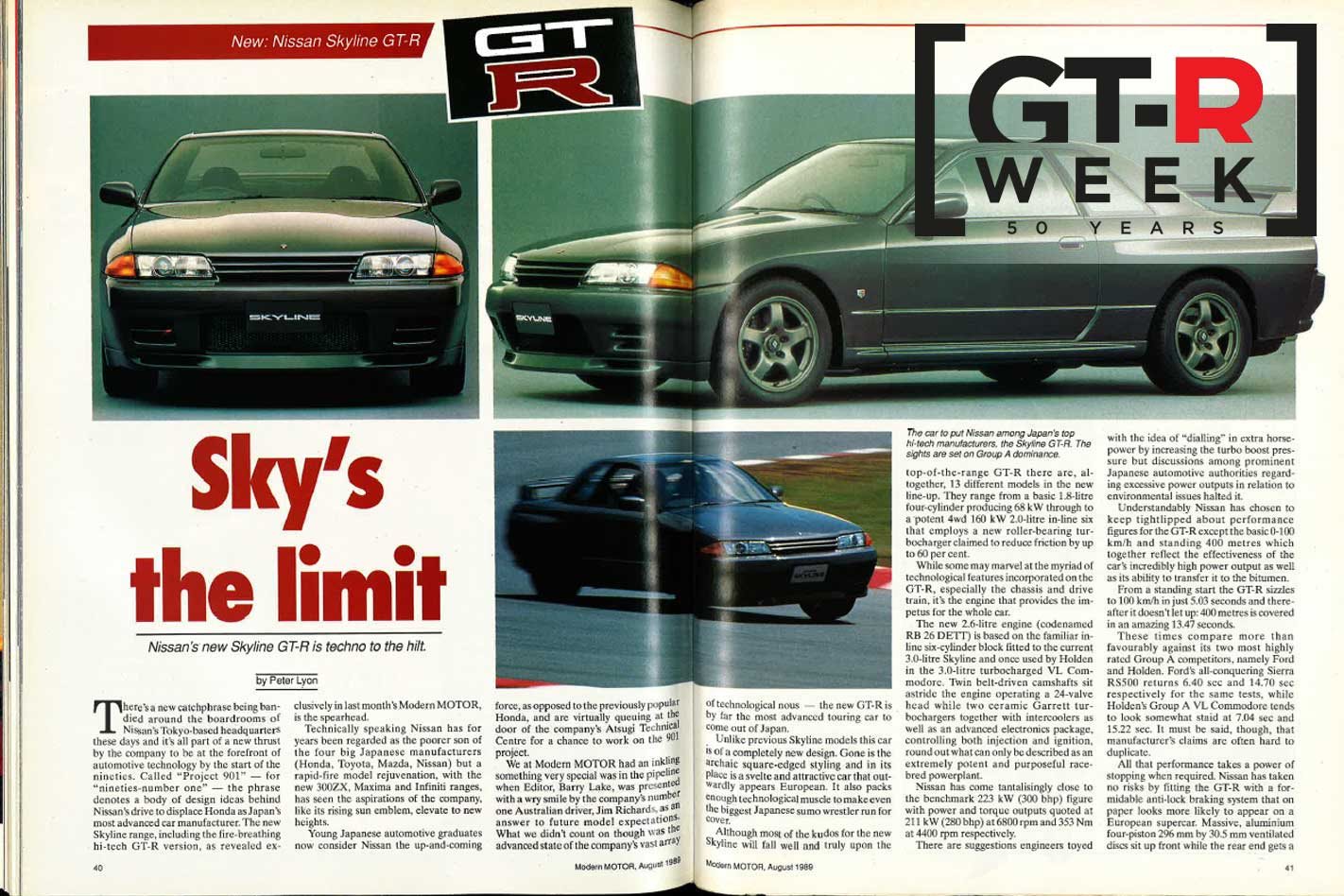There’s a new catchphrase being bandied around the boardrooms of Nissan’s Tokyo-based headquarters these days and it’s all part of a new thrust by the company to be at the forefront of automotive technology by the start of the nineties.
This feature was originally published in Modern MOTOR’s August 1989 issue
Called “Project 901” for “nineties-number one” the phrase denotes a body of design ideas behind N issan’s drive to displace Honda as Japan’s most advanced car manufacturer. The new Skyline range, including the fire-breathing hi-tech Nissan R32 Skyline GT-R version, as revealed exclusively in last month’s Modern MOTOR, is the spearhead.
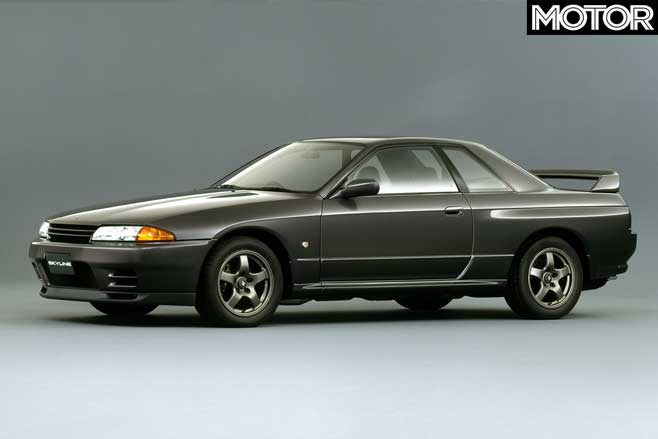
Young Japanese automotive graduates now consider Nissan the up-and-coming force, as opposed to the previously popular Honda, and are virtually queuing at the door of the company’s Atsugi Technical Centre for a chance to work on the 901 project.
We at Modern MOTOR had an inkling something very special was in the pipeline when Editor, Barry Lake, was presented with a wry smile by the company’s number one Australian driver, Jim Richards, as an answer to future model expectations. What we didn’t count on though was the advanced state of the company’s vast array of technological nous – the new GT-R is by far the most advanced touring car to come out of Japan.
Unlike previous Skyline models this car is of a completely new design. Gone is the archaic square-edged styling and in its place is a svelte and attractive car that outwardly appears European. It also packs enough technological muscle to make even the biggest Japanese sumo wrestler run for cover.
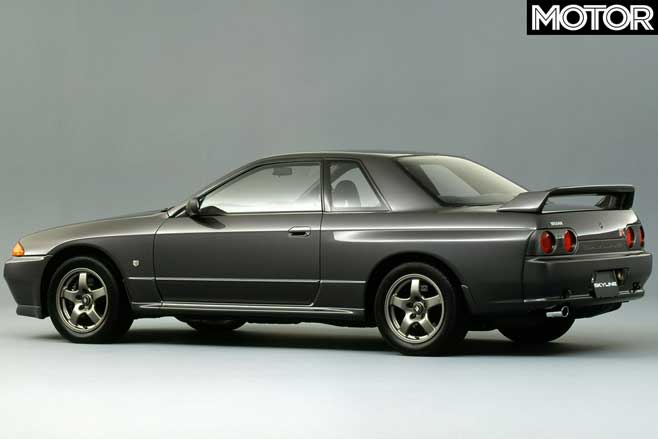
Although most of the kudos for the new Skyline will fall well and truly upon the top-of-the-range GT-R there are, altogether, 13 different models in the new line-up. They range from a basic 1.8-litre four-cylinder producing 68kW through to a potent 4WD 160kW 2.0-litre in-line six that employs a new roller-bearing turbocharger claimed to reduce friction by up to 60 per cent.
While some may marvel at the myriad of technological features incorporated on the GT-R, especially the chassis and drivetrain, it’s the engine that provides the impetus for the whole car.
The new 2.6-litre engine (codenamed RB26DETT) is based on the familiar inline six-cylinder block fitted to the current 3.0-litre Skyline and once used by Holden in the 3.0-litre turbocharged VL Commodore. Twin belt-driven camshafts sit astride the engine operating a 24-valve head while two ceramic Garrett turbochargers together with intercoolers as well as an advanced electronics package, controlling both injection and ignition, round out what can only be described as an extremely potent and purposeful race-bred powerplant.
Nissan has come tantalisingly close to the benchmark 223kW (300bhp) figure with power and torque outputs quoted at 211kW (280bhp) at 6800rpm and 353Nm at 4400rpm respectively.
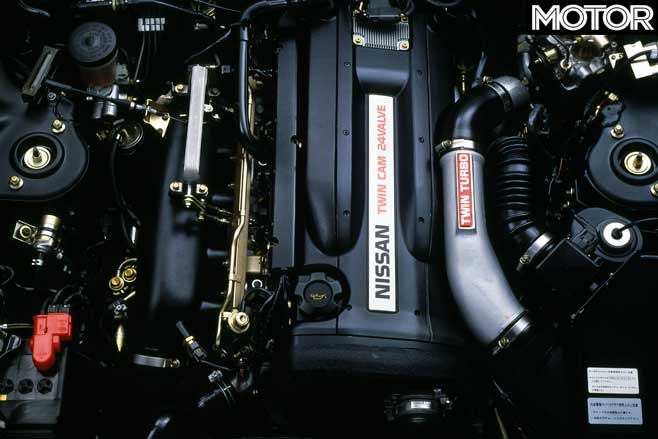
There are suggestions engineers toyed with the idea of “dialling” in extra horsepower by increasing the turbo boost pressure but discussions among prominent Japanese automotive authorities regarding excessive power outputs in relation to . environmental issues halted it.
Understandably Nissan has chosen to keep tightlipped about performance figures for the GT-R except the basic 0-100km/h and standing 400m which together reflect the effectiveness of the car’s incredibly high power output as well as its ability to transfer it to the bitumen.
From a standing start the GT-R sizzles to 100km/h in just 5.03 seconds and thereafter it doesn’t let up: 400m is covered in an amazing 13.47 seconds.
These times compare more than favourably against its two most highly rated Group A competitors, namely Ford and Holden. Ford’s all-conquering Sierra RS500 returns 6.40sec and 14.70sec respectively for the same tests, while Holden’s Group A VL Commodore tends to look somewhat staid at 7.04sec and 15.22sec. It must be said, though, that manufacturer’s claims are often hard to duplicate.
All that performance takes a power of stopping when required. Nissan has taken no risks by fitting the GT-R with a formidable anti-lock braking system that on paper looks more likely to appear on a European supercar. Massive, aluminium four-piston 296mm by 30.5mm ventilated discs sit up front while the rear end gets a two-piston 297mm by 18mm variety.
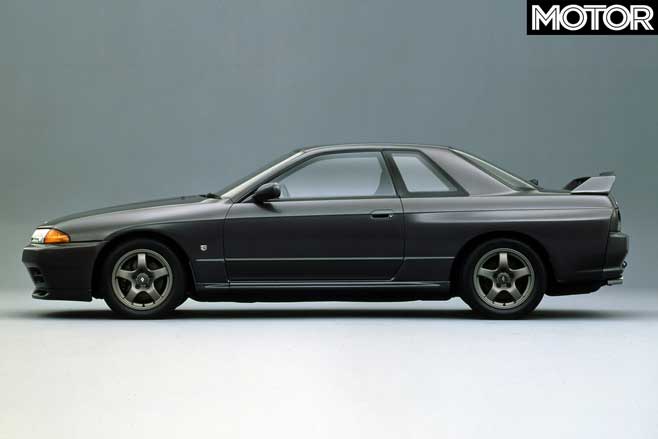
With such a lofty power output in road going form, it was essential to engineer a transmission and drivetrain set-up that could handle the quoted power output of 410kW (550bhp) at 7600rpm which the car is said to be developing in Group A trim.
And that Nissan has. It’s called ATTESA ETS or, for the techno minded, Advanced Total Traction Engineering System for All terrains and Electronic Torque Split. It is unique among production four wheel drive systems as it employs an accelerometer to detect lateral or sideways movements and adjusts the torque split (power) accordingly to each wheel. Other manufacturers are known to be working on such systems but Nissan is the only company confident enough to put one into production.
Put simply the ATTESA ETS system consists of a computer controlled multi-plate clutch encased in oil as well as a hydraulic unit triggered by changes in thc speed sensors and accelerometer, which applies pressure to the clutch to vary torque split.
Driving through a Trojan-like five-speed gearbox and limited-slip differential, the hydraulic unit reduces torque to the front wheels as lateral movement is increased, thus combining the cornering characteristics of a conventional rear wheel drive set-up together with the sure-footed traction provided by four-wheel drive.
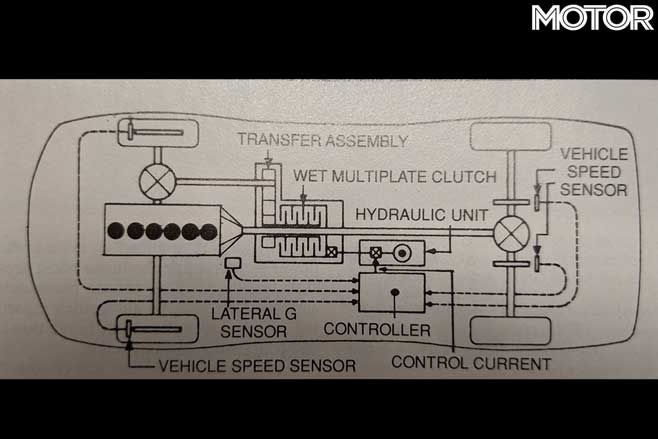
One thing we must dispute though 15 Nissan’s claim that ATTESA ETS is the first 4WD system to be combined with anti-lock braking. Lancia has been developing such a system for a number of years now and recently unveiled a production version on the new 16-valve Delta Integrale.
Nissan obviously considers its new ATTESA ETS system is ready to withstand the enormous stresses encountered during the rigors of competitive Group A motor racing. This is certainly not the first time 4WD has been considered for the race track: Lotus once raced an all-wheel drive car in Formula One, but in recent times weight has prohibited manufacturers from even contemplating such a move. Our bet is that, rule book permitting, Nissan will develop the ATTESA ETS system for fitment on its potent Group C sportscar challenger which recently qualified in 12th position at the Le Mans 24 hour race.
The new Skyline’s suspension also sets new standards for Nissan. The car is fitted with the company’s recently developed multi-link suspension set-up which first appeared on the new 300ZX. Its history has a novel twist in that its design was spawned out of an ideas basket initiated by the company’s 901 chassis development leader, Takaaki Uno, who took aside his engineers and asked them to generate at least 100 new design proposals for future models.
A number of front-end multi-link setups were tested before a final production version was chosen using a lateral link, a trailing strut and a diagonal upper control link which locates the steering knuckle on each side of the car.
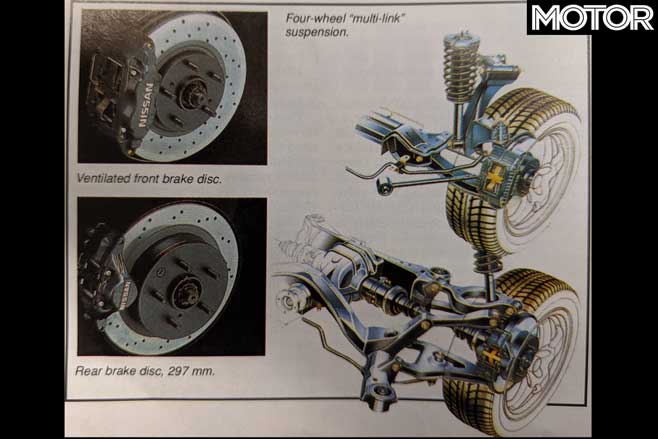
It’s obvious Nissan’s engineers had a long hard look at other manufacturers‘ setups and while some may regard the Skyline’s front suspension as revolutionary it is in essence a sophisticated version of the tried and proven independent set-up that utilises unequal length upper and lower control arms. It is also strikingly similar to the system used by Honda except that it employs one extra link between the knuckle and the upper locating link.
From the ground up the GT-R exudes aggressiveness and this is nowhere more evident than the rubber with which the car is shod. Meaty 225/50 R16 92V Bridgestone RE71 Potenza radials sit upon equally purposeful 8JJx16 alloy wheels providing the sort of grip and traction a car with 211kW on tap requires. The five-spoke wheel design supplies substantial airflow to the braking system and blends well with the car’s styling.
Similarly interesting as the new ATTESA ETS 4WD is Nissan’s new Super HICAS four-wheel steering system another Skyline GT-R first.
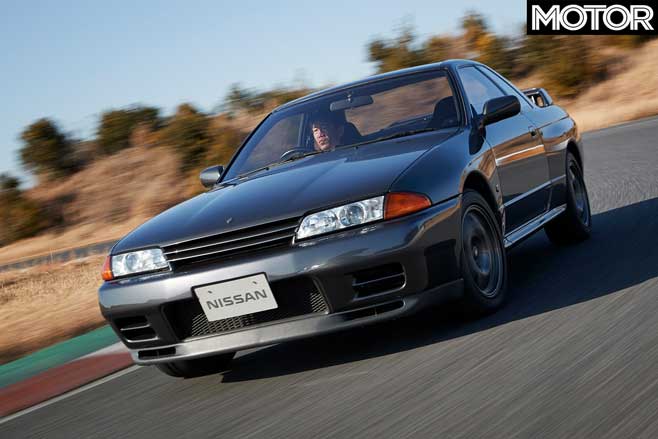
The 4WS system employed on the GT-R is a third generation version of the original Super HICAS system. Whereas the older system was often criticised for its ungainly low-speed manoeuvrability, the new Super HICAS does away with that by initially turning the rear wheels in the opposite direction to those at the front before switching back the other way to run in unison.
This, says Nissan, improves lowdown steering responsiveness and feel while still maintaining the useful gains during high-speed cornering. While it is in effect similar to Honda’s patented 4WS system its operation is by hydraulic pressure, depending upon its speed and angle, as opposed to conventional mechanical gears.
In a racing environment the Super HICAS 4WS system, together with the GTR’s power-assisted rack and pinion steering, should prove most useful on tight and twisty circuits where cornering speeds, as opposed to outright top-end speed, come into play.
Those lucky enough to have driven the GT-R say its the best handling car to come out of Japan – high praise when you consider the numerous models the country pumps out each year. Four-wheel steering is still an unknown quantity on the race track but from our experience, given the right circumstances, it should perform well.
With such impressive mechanical credentials the Skyline’s body stylists certainly had the job before them especially when you consider the two varying functions the car is expected to perform. On one hand it must act as a slightly upmarket family-orientated sedan while on the other it must fulfil the role of an all-conquering race car.

As with Nissan’s engineers, the stylists have risen to the task well and sculpted an extremely attractive package. There’s no doubting, the curvaceous but aggressive styling is definitely a winner. Sure there’s nothing to stamp the styling as revolutionary but the addition of rear-wheel arch blisters, side-skirting, a large front air dam and a high boot mounted spoiler combine to make the GT-R one of the most attractive while at the same time purposeful cars to come out of Japan.
But attractiveness doesn’t always augur well in the aerodynamics department! The GT-R‘s rather “clumsy” 0.40Cd atests to that and, together with the car’s hefty kerb weight of 1430kg, must pose at least a few problems for the engineers at NISMO (Nissan’s racing department) whose job it is to develop the car into a lean and mean winning machine.
For weight saving purposes Nissan has fitted an aluminium bow net and front panels. But with such extensive chassis mechanicals the GT-R was always going to be a heavyweight. For comparison, the Sierra RS500 and Group A Commodore tip the scales at 1240kg and 1410kg respectively.
Much of the GT-R’s poor aerodynamics can be contributed to the wide Bridgestone RE71 Potenza tyres as well as the added aerodynamic aids which, on the ram track, are necessary to provide optimal downforce for high-speed stability. The more sedate two and four-door Skylines vary from a respectable 0.31 through to 0.33.
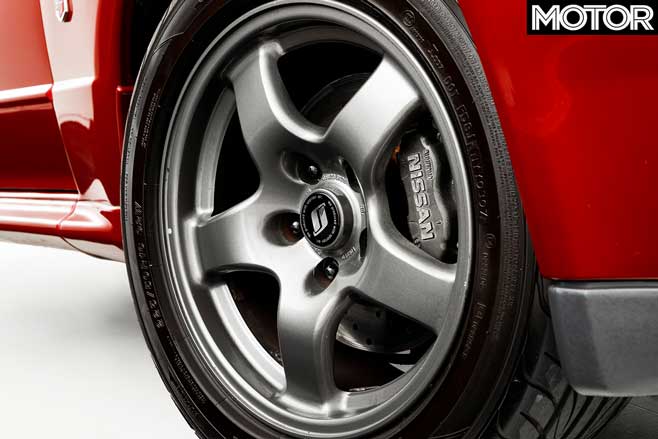
The ever increasing trend by Japanese manufacturers toward rounded tail lights is continued throughout the Skyline range and when viewed from the rear the GT-R conjures up memories of the early Mazda RX-series rotaries that boasted the round light treatment.
Considering the purpose of the GT-R, its interior appointments are extremely high in specification. Unlike other cars intended to perform race-track duties there are no obvious weight saving measures incorporated into GT-R’s interior. The instrument layout provides a stimulating and functional driving environment.
A large speedometer and tachometer (redlined at 8000rpm) dominate the dash while an array of secondary switch controls are mounted high around the binnacle within easy finger-tip reach of the steering wheel. Other controls, including a turbo boost gauge, are positioned on a centre console which slopes downwards and integrates with the transmission tunnel. The seats and their lowly-placed position as well as the thick leather gripped three-spoked steering wheel further enhance the interior’s sporty theme.
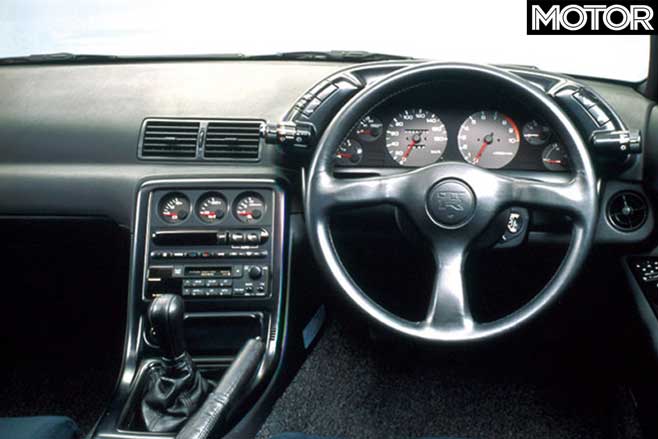
As one may expect of such a car the new GT-R is the toast of the Japanese automotive fraternity. But it doesn’t end there. Nissan has big plans for the entire Skyline range prime target being Toyota’s big-selling Cressida.
Unfortunately it has not been decided whether Australia will even get the car at this stage. Insiders say the car is being evaluated and with Nissan’s current Australian manufacturing plants being retooled to produce the forthcoming AD50 Matilda project, to be shared by Ford and Nissan, the bet is that with such an expansive model line-up the Australian subsidiary will think long and hard before it makes any firm decision.
Word is that Nissan at this stage intends to market the desirable GT-R on the domestic Japanese market only. It seems the Japanese have finally discovered that if you have a car as good as the GT-R you keep it to yourself and it’s certain Nissan will have no trouble in finding customers for the compulsory 500 evolution models required under Group A regulations.
From the leather-gripped steering wheel through to the high rear-deck spoiler the Skyline’s intentions are clear: to succeed both in the marketplace and on the world’s motor racing circuits. If it does prove successful will be stamped revolutionary. If it fails you can be sure the number crunchers at Nissan will pour millions of dollars into improving it.
While we don’t fully agree with Nissan’s claims that the new Skyline has unlimited potential, it certainly elevates the already keen awareness of Japan’s unrelenting push towards automotive supremacy.
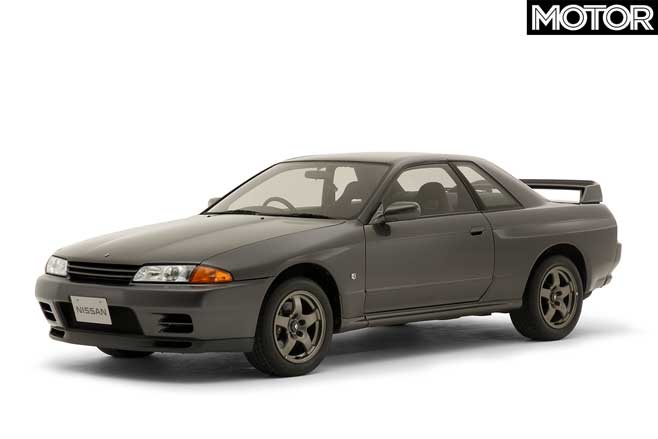
FAST FACTS 1989 Nissan R32 Skyline GT-R BODY: 2-door, 2+2 seat coupe DRIVE: electronically controlled torque-split all-wheel drive ENGINE: 2568cc inline-6, DOHC, 24v, twin-turbocharged BORE/STROKE: 86.0 x 73.7mm COMPRESSION: 8.5:1 POWER: 211kW @ 6800rpm TORQUE: 353Nm @ 4400rpm SPECIFIC OUTPUT: 82.2kW/litre WEIGHT: 1430kg (kerb) POWER-TO- WEIGHT: 148kW/tonne TRANSMISSION: 5-speed manual SUSPENSION (f): independent by “multi-link” system – unequal upper and lower control arms with coil springs and anti-roll bar SUSPENSION (r): independent by “multi-link” system with coil springs and anti-roll bar L/W/h: 4545/1755/1340mm WHEELBASE: 2615mm TRACKS: 1480/1480mm (f/r) GROUND CLEARANCE: 135mm STEERING: power-assisted rack-and-pinion; rear-steering by shaft/computer controlled gearbox BRAKES: 296mm steel ventilated discs, 4-piston calipers (f); 297mm steel ventilated discs, 2-piston calipers (r) WHEELS: 16.0 x 8.0-inch (f/r) TYRES: Bridgestone Potenza RE71; 225/50 VR16 (f/r) PRICE: $110,000 (new)
Performance figures 0-100km/h: 5.05sec 0-400m: 13.47sec

